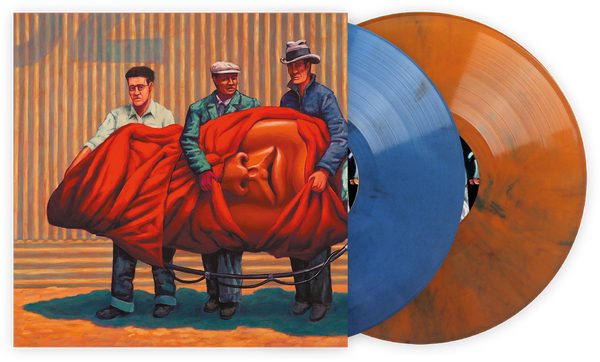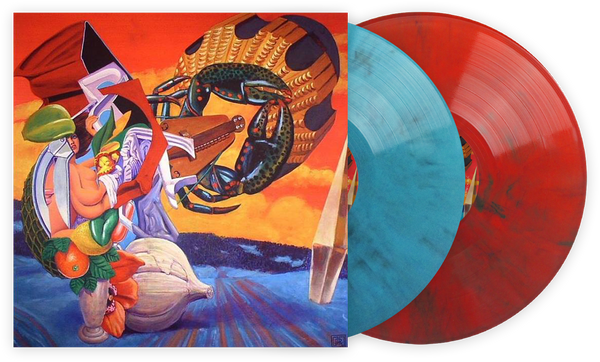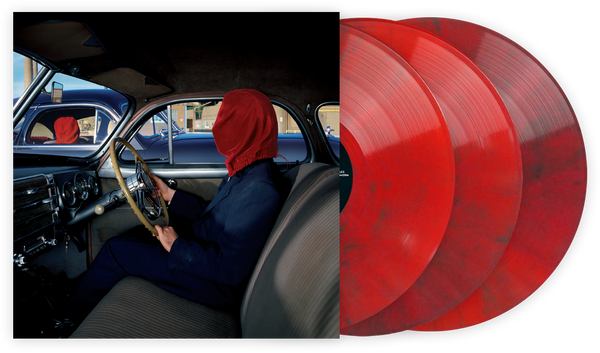The Mars Volta. Jeśli jesteś fanem, to ty — jak ja — rozumiesz, jak to jest próbować wprowadzić kogoś w tę grupę. Po pierwsze, rock progresywny to nie jest łatwy gatunek, aby się w niego wdrożyć. Często jest on celowo tworzony w sposób, który czyni go niedostępnym — te długie, epickie dźwiękowe podróże sprawdzają cierpliwość z nadzieją, że przestroją słuchacza i poszerzą jego muzyczne horyzonty. To można bez wątpienia powiedzieć o Volcie, grupie, która wzięła fundamenty rocka progresywnego takich zespołów jak Pink Floyd, Frank Zappa i King Crimson, i zdefiniowała — oraz redefiniowała — gatunek na lata 2000. Liderzy Volty, Omar Rodríguez-López i Cedric Bixler-Zavala, nigdy nie wstydzili się swojej samouwielbienia z tą grupą. Tworzą to, co chcą usłyszeć; jeśli zostaniesz z nimi, super — jeśli nie, cóż, to też jest w porządku.
Z sześcioma albumami studyjnymi na swoim koncie, jestem przekonany, że The Mars Volta ma coś dla każdego, nawet jeśli nie wszyscy są przekonani, że ten zespół to robi. Chociaż grupa pozostała zakorzeniona w prog rocku przez te sześć albumów, eksperymentowali z ich brzmieniem na różne sposoby — od maksymalizacji dźwięku po wydanie albumu, który określają jako akustyczny (choć technicznie to nie jest). Wraz z tym, wydali również kilka singli, które pokazują ich różnorodność: smutne walce i latynoskie funk-rockowe groove'y — jeden z nich przyniósł zespołowi ich pierwszego (i jedynego) Gramy.
Aby naprawdę doświadczyć The Mars Volta, najlepiej jest skonsumować ich projekt tak, jak zamierzali: w całości. Wiem, jak trudne to może być, zwłaszcza dla wtajemniczonych. Jeśli nie jest to nietypowa instrumentacja, to głos Bixlera-Zavala. I zamiast dać Ci odpowiedź, którą kiedyś udzielałem ludziom, którą myślałem, że brzmi tak cool (“Po prostu nie rozumiesz The Mars Volta”), powiem tylko to: Spróbuj i daj jednemu z tych albumów szansę na podstawie tego, jak są kategoryzowane. Niezależnie od tego, czy szukasz najbardziej dostępnego albumu, czy może po prostu próbnego EP, to mam nadzieję, że ten przewodnik pomoże tym, którzy są ciekawi The Mars Volta, stać się fanami lub przynajmniej zrozumieć, dlaczego ten twój znajomy tak bardzo ich kocha.
Dostępnego nie jest słowem powszechnie używanym w kontekście The Mars Volta, ale dwa albumy, które mógłbym polecić, to ich pierwszy album, De-Loused in the Comatorium, lub ich ostatni album, Noctourniquet. Ten pierwszy jest lepszy z dwóch, po prostu dlatego, że czuje się jak album Volta: koncepcyjny, rozrzutny, epicki — prawdziwy klasyk prog rocka. Ten drugi ma nietypowość, która od samego początku była integralna dla zespołu, ale jest znacznie bardziej bezpośredni i mniej ekstrawagancki. To, że Rodríguez-López opisał Noctourniquet jako “punk przyszłości” jest trafne. To album, który bardziej odpowiada Antemasque (krótkotrwałemu zespołowi pobocznemu Rodríguez-Lópeza i Bixlera-Zavala) niż The Mars Volta, i oferuje wgląd w to, jakim mogła być Volta, gdyby bardziej skupiła się na estetyce ich ukochanego At the Drive-In z większą dawką — zamiast całej butelki — eksperymentów prog rocka.
Ale także, De-Loused to album, który wszystko rozpoczął. De-Loused jest stosunkowo spójny i przyswajalny w porównaniu do swoich następców; udział Ricka Rubina jako producenta podobno przyczynił się do tej spójności. Eksperymentacja tutaj jest stosunkowo łagodna; kinowe odcinki — narastająca cisza, która rozpoczyna “Son et Lumière” lub echa wodnych kropli w drugiej części “Cicatriz ESP” — nie są zbyt rozrzutne, i w rzeczywistości sprawiają, że De-Loused wydaje się być albumem koncepcyjnym. Utwory są skonstruowane w prosty sposób, nawet jeśli zespół zbacza z utartego szlaku w postaci długich sesji jamowych, jak w przypadku wspomnianej już “Cicatriz ESP” (która zawiera podwójne solówki gitarowe od Rodríguez-Lópeza i Johna Frusciante) oraz zamykającego album “Take The Veil Cerpin Taxt.” Wszystko to ma na celu ożywienie narracji De-Loused, która, pod enigmatycznymi tekstami Bixlera-Zavala, jest w rzeczywistości hołdem dla Julio Venegasa. Muzykant, malarz i pisarz, Venegas zmarł 15 lutego 1996 roku w El Paso w Teksasie, kiedy skoczył z wiaduktu i spadł na autostradę Interstate 10 w czasie popołudniowego ruchu.
“On był naszym mentorem, nauczył nas wszystkiego, co stworzyło to, czym dzisiaj jesteśmy, w zasadzie,” powiedział Bixler-Zavala o Venegasie w wywiadzie z 2004 roku na Rockcircustv. “Julio to tylko przykład głodującego artysty — kogoś, kto zawsze zmagał się z trudnościami, a kiedy się zmagasz, twoja sztuka to pokazuje, a on był żywym, chodzącym ucieleśnieniem tego, czym jest sztuka lub czym powinna być.”
De-Loused czuje — i brzmi — jak epicka tragedia. W całym albumie obecna jest smutek, najsłynniej w “Televators,” jego przedostatnim utworze. “Televators” wyróżnia się spośród reszty; to ballada, która stopniowo rośnie w intensywności, napędzana akustyczną gitarą Rodríguez-Lópeza i wokalami Bixlera-Zavala. Jeśli jest jakikolwiek utwór, który podsumowuje genialność De-Loused, to jest to “Televators.” Ale, aby tam dotrzeć — i aby zrozumieć album w ogóle — musisz przesłuchać De-Loused w całości. Album to immersyjna podróż; pierwszy z wielu wydania Volta, które wymagają od słuchaczy, aby w pełni zanurzyli się w ich prog rockowej otchłani, nawet jeśli po drodze się zgubią.
Warto zauważyć, że na początku tego roku zespół wydał Landscape Tantrums: Unfinished Original Recordings of De-Loused in the Comatorium. Mars Volta nigdy wcześniej nie wydało czegoś takiego oficjalnie. (Dlatego aż do tego momentu, zagorzałe fani polegali na oprogramowaniu peer-to-peer, takim jak LimeWire, a później YouTube, aby słuchać bootlegowych wersji wczesnych nagrań “Roulette Dares” i “Cicatriz ESP.”) To prawdziwa gratka, ponieważ jest intymna w swojej surowości — od niespójnej mieszanki, która sprawia, że wszystkie instrumenty brzmią, jakby były na tych samych poziomach (ostateczna wersja “Drunkship of Lanterns” powinna zachować głośne kongi jak oryginał) po “Televators” bez atmosferycznych pejzaży dźwiękowych, które sprawiają, że to, czym jest. Landscape Tantrums prawdopodobnie również zawiera byłych członków, takich jak klawiszowiec Jane’s Addiction, Linda Good, i basista (oraz przyjaciel i długoletni współpracownik Rodríguez-Lópeza i Bixlera-Zavala) Ralph Jasso, pokazując, jak ci członkowie przyczynili się do tego, co De-Loused stało się (zmarły klawiszowiec Jack White, Isaiah “Ikey” Owens, i Flea z Red Hot Chili Peppers, kończyli rejestrować klawisze i bas, odpowiednio), ale również zaoferowali własną, odmienną interpretację tych utworów. Polecałbym posłuchać De-Loused przed Landscape Tantrums, żebyś mógł usłyszeć, jak wiele zmieniło się od oryginalnych nagrań do ostatecznej wersji.
Wydane w kwietniu 2002 roku, Tremulant zapowiadał to, co miało nadejść z wydaniem De-Loused in the Comatorium w następnym roku. Trzyutworowe EP zawiera najlepsze prace zespołu, szczególnie dwa ostatnie utwory: “Concertina” i “Eunuch Provocateur.” Ten pierwszy to piękny, smutny walc; zwrotki są ciche, a dysonansowa gitara Rodríguez-Lópeza odbija się między delikatnymi bębnami Jona Theodore'a a wyraźnymi uderzeniami basu Ewy Gardner. Gdy nadchodzi refren, zespół jest dynamiczny i głośny, prowadzony enigmatycznymi tekstami Bixlera-Zavala: “Czy te cienie będą się świecić, z tego pustego spojrzenia w ciszy pustki.” “Concertina” można uważać za prequel De-Loused; podobnie jak album, utwór jest inspirowany ukochanym przyjacielem Bixlera-Zavala i Rodríguez-Lópeza, zmarłym Julio Venegasem. Ale również twierdzi się, że jest o Benie Rodriguezie, byłym gitarzyście trasującym z zespołem At the Drive-In, i o tym, jak przyczynił się do śmierci Venegasa. “Eunuch Provocateur,” z którego pochodzi tytuł pierwszego albumu zespołu, to energetyczne zakończenie EP; latynoski rytm, który napędza zwrotki, posłużył jako zapowiedź podobnych utworów jak “Drunkship of Lanterns” z De-Loused, i pokazuje, jak zespół z genialnością łączy swoje latynoskie i punkowe korzenie, aby stworzyć odmienny dźwięk.
W czasie swojego drugiego wydania, Volta była w pełni prog rockiem. Tylko jedna piosenka z Frances the Mute trwa poniżej 10 minut: pierwszy i jedyny hymn zespołu “The Widow” — który przypuszczam, że został poparty przez Kanye Westa na podstawie tego tweeta — który kończy się długim outro, które oczywiście nie znalazło się w wersji radiowej utworu. Pozostałe utwory mają ponad 10 minut, a jeden z nich ma 32 minuty i 32 sekundy (“Cassandra Gemini”). Frances to pierwszy album Volta, który naprawdę czuje się samolubnie, i mam na myśli to w dobrym sensie. Jak bardzo fani się zgadzają lub nie zgadzają z bezwstydnym muzycznym samolubstwem Rodríguez-Lópeza i Bixlera-Zavala, dodaje to urokowi zespołu, a Frances jest bez wątpienia najspójnieszym — chociaż wciąż wyzwaniem — doświadczeniem słuchowym i przykładem tego. Otwierający album “Cygnus...Vismund Cygnus” kończy się trzema minutami ambientowego hałasu. “Cassandra Gemini” dzieli się na osiem części. Frances testuje cierpliwość jednego, nie tylko długością utworów, ale także eksperymentacją, nagradzając słuchaczy kolejnym ambitnym projektem, który zawiera jedne z największych momentów muzycznych zespołu.
“Cygnus...” jest genialnie wyważony: Nietypowy groove pierwszej połowy jest tak silny i dynamiczny, że kiedy nadszedł most, serdecznie powitasz jego ambientową ciszę, dając sobie chwilę na złapanie oddechu, zanim groove powróci jeszcze mocniej. I, oczywiście, jest “L’Via L’Viaquez,” utwór zatwierdzony przez Guitar Hero World Tour, który zawiera dwie oszałamiające solówki gitarowe Frusciante, jak również fenomenalną solówkę fortepianową od zmarłego legendarnego pianisty salsy (i jednego z największych wpływów Rodríguez-Lópeza) Larry'ego Harlow.
Frances zapowiadał dyktatorskie podejście Rodríguez-Lópeza aż do ich ostatniego albumu, Noctourniquet. Gdzie De-Loused miał Rubina, aby pomóc Rodríguez-Lópezowi kontrolować jego bardziej awangardowe pochylenia, Frances (i każdy album Volta po nim) był produkowany tylko przez Rodríguez-Lópeza. To, przypuszczalnie, jest powód, dla którego ten album jest bardziej ambitny i nietradycyjny. Rodríguez-López wcielił swojego wewnętrznego reżysera i wyreżyserował swoich kolegów z zespołu, aby ożywić jego artystyczną wizję.
Amputechture jest uważany za album, który podzielił fanów Volta na dwa: tych, którzy chcieli, żeby zespół powrócił do eksperymentalnego — ale wciąż przyswajalnego — brzmienia à la De-Loused, oraz tych, którzy chcieli, aby zespół przeszedł jeszcze głębiej w nieznane prog rocka, jak zrobili to z Frances. Ci z tej drugiej kategorii byli zapewne bardziej otwarci na Amputechture, który jest łatwo jednym z najbardziej wymagających wydań zespołu. Trzy utwory z Amputechture mają ponad 10 minut długości, z każdym zawierającym wiele muzycznych ruchów. Z tego powodu Amputechture można uznać za najbardziej filmowy album Volta, z Rodríguez-Lópezem wdrażającym bardzo reżyserskie podejście do tworzenia tego projektu.
“Proces, który stosowałem na ostatnich dwóch albumach Mars Volta polegał na tym, że wszystko jest nagrywane w nieuporządkowanej i nielinearnej kolejności,” powiedział w wywiadzie z 2006 roku dla Guitar World. “Jednego dnia mogę nagrać wszystko, co jest w jednym konkretnym tonacji. Innego dnia mogę nagrać wszystko bardzo cicho, lub wszystko, co jest głośne i szorstkie. Dlatego wykonawcy nie mają naprawdę kontekstu, co jest przed i po, ani jak współdziałają w utworze.”
Amputechture jest niepodważalnie najbardziej bezkompromisowym przedsięwzięciem zespołu, a okładka stworzona przez malarza Jeffa Jordana idealnie to oddaje. Niepokojący i dziwaczny, ale także dziwnie piękny i hipnotyzujący, obraz Jordana “Big Mutant” jest odpowiednim wizerunkiem dla tego albumu. Jeśli czujesz się zniechęcony przez Amputechture, przynajmniej posłuchaj dzikiej solówki basowej Juana Alderete na początku “Day of the Baphomets,” a następnie obejrzyj ten film z występu zespołu na żywo w The Henry Rollins Show, aby zobaczyć, jak genialna jest solówka Alderete.
Jeśli kiedykolwiek widziałeś komedię z 2010 roku Get Him to the Greek, to słyszałeś część Scabdates wcześniej. Kulminacja występów na żywo od maja 2004 do maja 2005, Scabdates łączy te występy z nagraniami polowymi — od płaczących dzieci po rozmowy z zaplecza — aby stworzyć album na żywo, który ma brzmieć tak, jakby pochodził z jednego występu. Ostateczny wynik tworzy nietypowy album na żywo, który uchwyca enigmatyczną etykę Volta, a także ich energetyczne i improwizacyjne występy na żywo. Dla bardziej bezpośredniego doświadczenia albumu na żywo, istnieje również ich 2003 Live EP, który składa się z czterech nagrań: dwóch z londyńskiego studia XFM (“Roulette Dares (The Haunt Of)” i “Drunkship of Lanterns”) oraz dwóch z Electric Ballroom w Londynie (“Cicatriz ESP” i “Televators”). Chociaż żaden z tych albumów nie jest dostępny na serwisach streamingowych, są dostępne na YouTube.
The Bedlam in Goliath ma co najmniej najbardziej fascynującą historię w tle spośród wszystkich albumów Volta. Podczas podróży do Jerozolimy Rodríguez-López kupił Bixler-Zavalę planszę Ouija jako prezent, z której obaj korzystali podczas swojej trasy w 2006 roku z Red Hot Chili Peppers. Im częściej jej używali, tym więcej dziwnych rzeczy działo się, podczas gdy pisali i nagrywali album — od zalania domowego studia Rodríguez-Lópeza po kryzys psychiczny oryginalnego inżyniera albumu. W nadziei na zdjęcie klątwy, jaką plansza nałożyła na album, Rodríguez-López złamał ją na pół i zakopał.
Bedlam’s historia początkowa dopasowuje się do apokaliptycznej atmosfery całego albumu. Każdy utwór ma ciemność i intensywność, przede wszystkim dzięki dynamicznemu i potężnemu bębnowi Thomasa Pridgena. Ale w jego ciężkości, Bedlam oferuje jedne z najbardziej popularnych utworów zespołu, w tym nagradzany Grammy singiel “Wax Simulacra” i “Goliath,” ten drugi to szybsza — i dramatycznie mniej spokojna — wersja “Rapid Fire Tollbooth” z albumu Rodríguez-Lópeza, Se Dice Bisonte, No Búfalo. Szczerze mówiąc, Bedlam jest najmniej spokojnym albumem Volta w dyskografii zespołu, co jest częścią jego uroku. To ich najgłośniejszy i najcięższy album, z każdym członkiem grającym — a w przypadku Bixlera-Zavala, śpiewającym — na swoim instrumencie, jakby życie od tego zależało. Co, biorąc pod uwagę, że plansza Ouija mogła lub nie mogła prowadzić do operacji stopy Bixlera-Zavala, może ich życie rzeczywiście od tego zależało.
To może być kontrowersyjna opinia, ale gdy przychodzi do dwóch niekonceptualnych albumów Volta (Amputechture i Octahedron), to ten drugi jest lepszym wyborem ogólnym. Nie tylko, że kontynuacja Bedlam zawiera więcej pamiętnych utworów — szczególnie mocarza jakim jest “Cotopaxi” i piękny otwieracz “Since We’ve Been Wrong” — ale jest to tak świeże odejście od wszystkiego, co zespół robił do tego momentu. Opisany przez Bixlera-Zavalę jako “nasza wersja tego, co uważamy za album akustyczny,” Octahedron jest zauważalnie goły. Po pierwsze, Adrián Terrazas-González, a także gitarzysta rytmiczny i manipulator dźwięku Paul Hinojos, nie byli już częścią zespołu. Również Isaiah “Ikey” Owens, który przyczynił się klawiszami do albumów zespołu od czasu De-Loused, nie był na albumie.
“To tak, jakbyśmy dostali zupełnie nowy zespół,” powiedział członek Volta (i jeden z braci Rodríguez-Lópeza) Marcel Rodríguez-López w wywiadzie z 2009 roku dla Drum magazine. “To o dwóch mniej członków — musieliśmy grać inaczej.”
To właśnie ta prostota sprawia, że Octahedron jest tak fascynujący. Tak wiele z Volty jest wielkich: Ile możemy zmieścić w jednym utworze? Ile dźwięków możemy zmieścić w jednym utworze? Na Octahedron widać, że nie martwili się tymi pytaniami. Postawili na lżejsze i bardziej bezpośrednie utwory, które pokazują, że mogą być strukturalnie konwencjonalni, jednocześnie utrzymując znane brzmienie. Posunąłbym się nawet do stwierdzenia, że “Since We’ve Been Wrong” to jeden z ich najlepszych utworów, szczególnie z perspektywy twórczej. Piękno jego dwóch kontrastujących melodii gitarowych, zaraźliwego refrenu Bixlera-Zavala i grzmiących perkusji Pridgena, które nadciągają w połowie utworu — jest to tak genialnie wyważone i skonstruowane, ale wciąż pozostaje niezaprzeczalnie Volta.
Elijah Watson is the Senior News & Culture Editor for Okayplayer. He has written for publications like The FADER, the Daily Beast and Complex. His work has been included in books like the Best Damn Hip Hop Writing: 2018, and he’s also a Webby Award winner. When he’s not writing or editing, he’s usually sleeping or watching video game explainer videos on YouTube.



